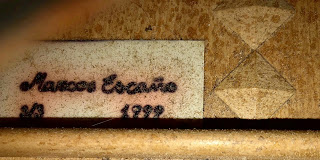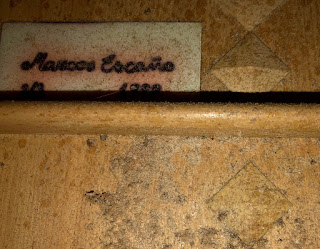The repaired Marcos Escano guitar from 1999. Though
an unknown luthier to this day, details are convincing
it to be a good instrument and very lightly built. What
could have been expected the guitar gives lots' of
volume. Scale length 645 mm Width topnut: 50 mm.
And the few cracks in the soundboard have been
treated to my satisfaction. Price 450 Euro's.
Hardly visible are the cracks here, Even after a
close inspection. On the left just above the bridge
you can see some traces of damage when I needed
to remove the bridge. As it was repaired by someone
else in an earlier stage but done with the wrong glue
the bridge came loose again. All stable now but the
amateur who did this should be ashamed....
A nicely sculpted head what betrays work of a real
woodworker. Everything is showing a high degree
of workmanship. Ebony fingerboard and newly
made topnut and bridgebone. Scale is 645 mm.
Width topnut is 50 mm.
The back of the head with the reinforcement
all the way up to the top of the head.
A nice cypress back with no frills but strange thing is
that nice inlays are made on the sides, a bit unusual...
Almost undamaged after 25 years of service.
Frets have been redressed and can deliver service
for years to come.
I think the tuners to be from Alhambra as the prefix "A"
can be detected here on the left. You need to know that
there actually is a prefix there!
And the tuners on the right side of this guitar.
The simple label and maybe this luthier didn't built
that many guitars. We hope to find out in the future.
Refently we heard about a Marcos Escano who is a
a quite successful musician in Spain. Most likely
he gave it a try: building guitars,
The blocks on the right from the label are a
reinforcement of the two halves of the back. A lot
of extra work as a strip of wood would have done
the job as well. This must have been done by someone
who is accustomed to wood working.



































